Gates Charles. Ancient Cities: The Archaeology of Urban Life in the Ancient Near East and Egypt, Greece and Rome
Подождите немного. Документ загружается.

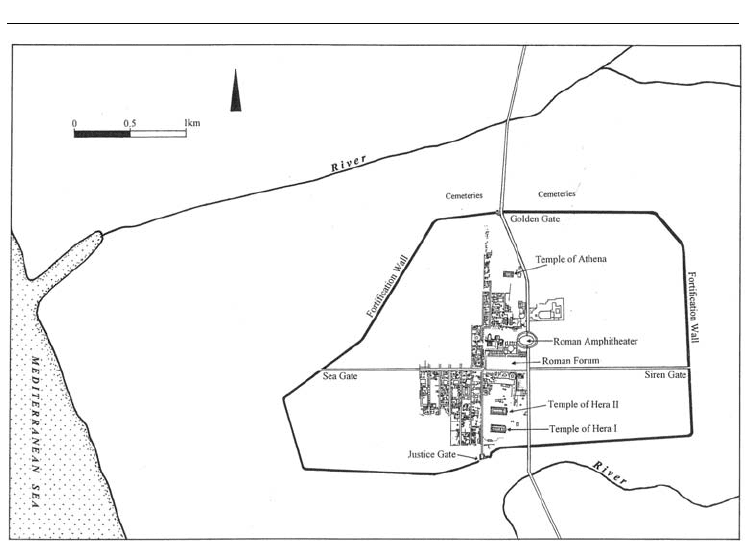
312 ANCIENT ITALY AND THE ROMAN EMPIRE
mity to the standard principles of Greek architecture, all show certain features of construction
and design that can be classified as regional west Greek practice. Some details, such as those that
anticipated solutions used in Periklean buildings on the Athenian acropolis, indicate that west
Greece was no architectural backwater, but instead a center of innovation.
The temples stand in a north–south line in the middle of the city, each oriented toward the
east. They are built of local stones, travertine (a local limestone) and sandstone, for unlike Aegean
Greece, marble was lacking in this region. The oldest is the Temple of Hera I, dated to the mid-
sixth century BC. Some of its features diverge from the expected. Measuring ca. 54.3m × 24.5m,
thus broader than usual, its colonnade has nine columns on the short sides, eighteen on the long.
In addition, the cella, whose floor is higher than that of the porch, a western Greek feature, has a
central row of columns, recalling – perhaps deliberately, perhaps accidentally – the earlier temple
of Hera on Samos. This row may have served to divide the sacred space into two, perhaps for
two cults, with one side for Hera, the other for Zeus. Columns feature a favorite Greek archi-
tectural refinement: entasis, a convex swelling, here almost a bulging out, of the vertical line. The
echinus, the lower half of the column capital, resembles a flattened mushroom with its especially
low, broad profile.
The second great temple, built ca. 500 BC, was dedicated to Athena, according to finds of
votive figurines recognizable as Athena (Figure 19.4). This temple, ca. 33m × 14.5m, has a col-
onnade with the normal six columns on the short sides, thirteen on the long, a front porch (pro-
naos) but no opisthodomos. Above the colonnade lies an unusual entablature: from bottom to
top, (a) an architrave of the usual sort, (b) an extra course of sandstone; (c) a triglyph and metope
frieze, not sculpted; and (d) a pedimental space without a horizontal cornice on the bottom, but
with, at the top, pronounced projecting raking cornices.
Figure 19.2 City plan, Paestum
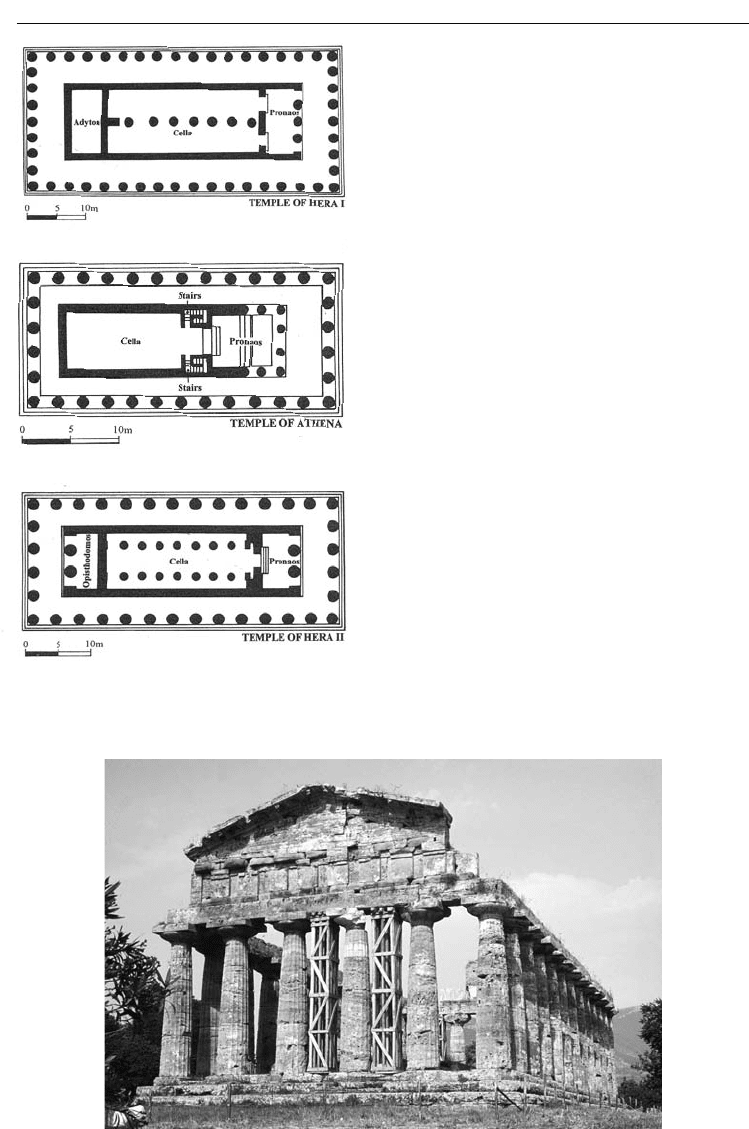
GREEK AND ETRUSCAN CITIES IN ITALY 313
When we enter the temple, we see that the
deep porch, set well behind the outer colonnade,
is framed by eight Ionic columns: four on the
façade and two on each side (the second of which
is engaged in the anta). This use of Doric and
Ionic columns in the same building marks the first
appearance of a combination so strikingly devel-
oped fifty years later on the Athenian acropolis.
The porch columns and cella walls are not aligned
with the columns of the outer colonnade – another
feature common in west Greece. The cella has no
interior columns, in contrast with the Temple of
Hera I, but two elaborate stairwells flank its door-
way, providing access perhaps to an upper room
overlooking the cella and the cult statue.
The last, largest, and best preserved of the three
is the Temple of Hera II, built ca. 470–460 BC next
to the earlier Temple of Hera I. Again, the votive
materials indicate the dedicatee. It measures ca.
60m × 24.25m. Its exterior columns, arranged six
on the short sides, fourteen on the long, were origi-
nally covered with stucco, in order to hide irregu-
larities in the stone and imitate marble – another
western Greek feature. Both porch and opisth-
odomos are present, each with two columns in
antis. The cella has two rows of internal columns,
thereby creating a nave and two aisles; the columns
directly supported the ceiling and roof, but not,
apparently, a gallery above the aisles. The exterior
Figure 19.4 Temple of Athena, Paestum
Figure 19.3 Plans, Archaic and Classical
temples from Paestum: Temple of Hera I,
Temple of Athena, and Temple of Hera II
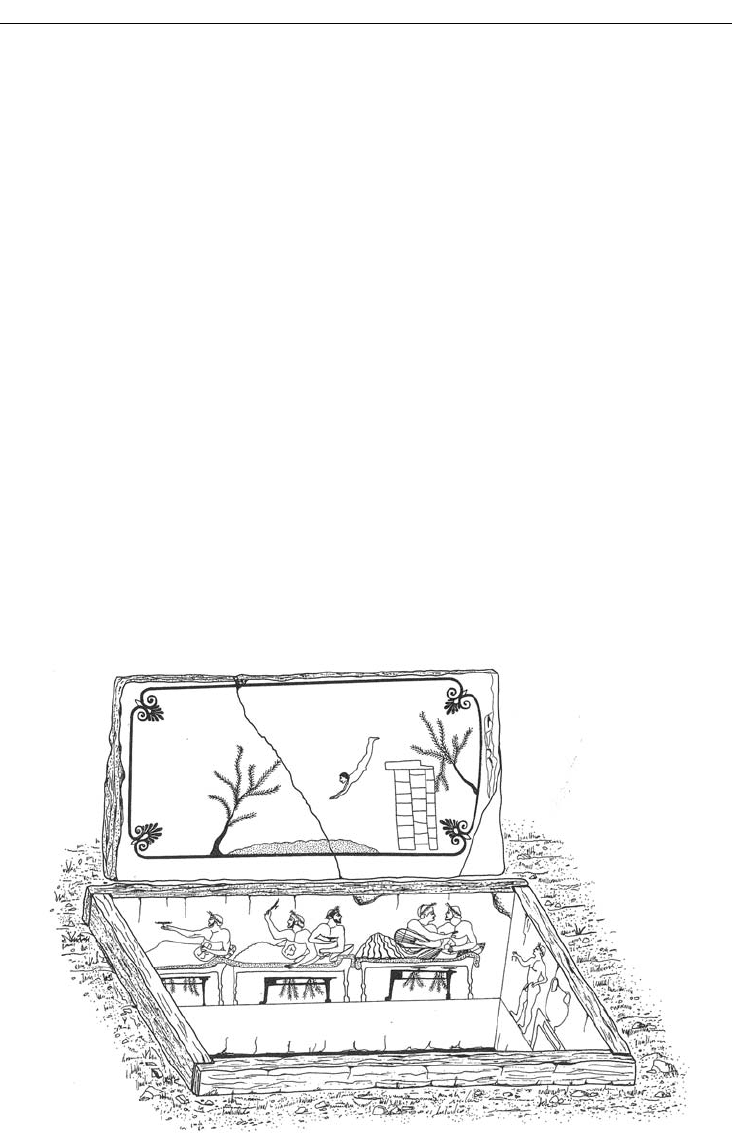
314 ANCIENT ITALY AND THE ROMAN EMPIRE
elevation is standard Doric. Neither metopes nor pediments were sculpted. Architectural refine-
ments include curvature of the stylobate, the slight tilting in of columns, and entasis, except for
the latter all rare in West Greece – but all will be present in the Parthenon.
The cemeteries lay outside the city, as was typical in the Greek world. Particularly striking is the
Tomb of the Diver of ca. 480 BC, discovered by Mario Napoli in 1968 during explorations 1.5km
to the south of the city. This simple burial of a man with few grave goods would hardly merit our
attention were it not for its well-preserved figural paintings, important survivals of panel paint-
ings from the Early Classical period. The tomb was constructed of five travertine slabs, four sides
and a lid, all painted, inserted into a rectangular cutting in the rock, fitting around an unpainted
floor (Figure 19.5). The underside of the lid illustrates a young man diving from a platform into
a pool, the scene that gives its name to the tomb. The four sides show men at a banquet, reclin-
ing on benches, with two per bench as was typical, and attendant servants and musicians. Two
pairs are romantically occupied, while others watch them or else play kottabos (a game in which
one flings wine dregs from a cup at a target), or play the flute and the lyre. The scenes seem
straightforward depictions of daily life, although because of the funerary context, we should keep
open the possibility of other meanings, such as funerary celebrations or activities projected for
the afterlife (see below, concerning Etruscan tomb art). In terms of composition and technique,
the painting consists of figures and objects placed on a ground line with no attempt at depth of
space, and solid colors (without shading or added internal details) within outlines – features that
we would expect of Archaic Greek art.
Syracuse
The island of Sicily, centrally located in Mediterranean just 3km from the Italian peninsula and
160km from Africa, has always been a crossroads of cultures. In Greco-Roman antiquity, Syracuse
Figure 19.5 Tomb of the Diver (reconstruction), Paestum
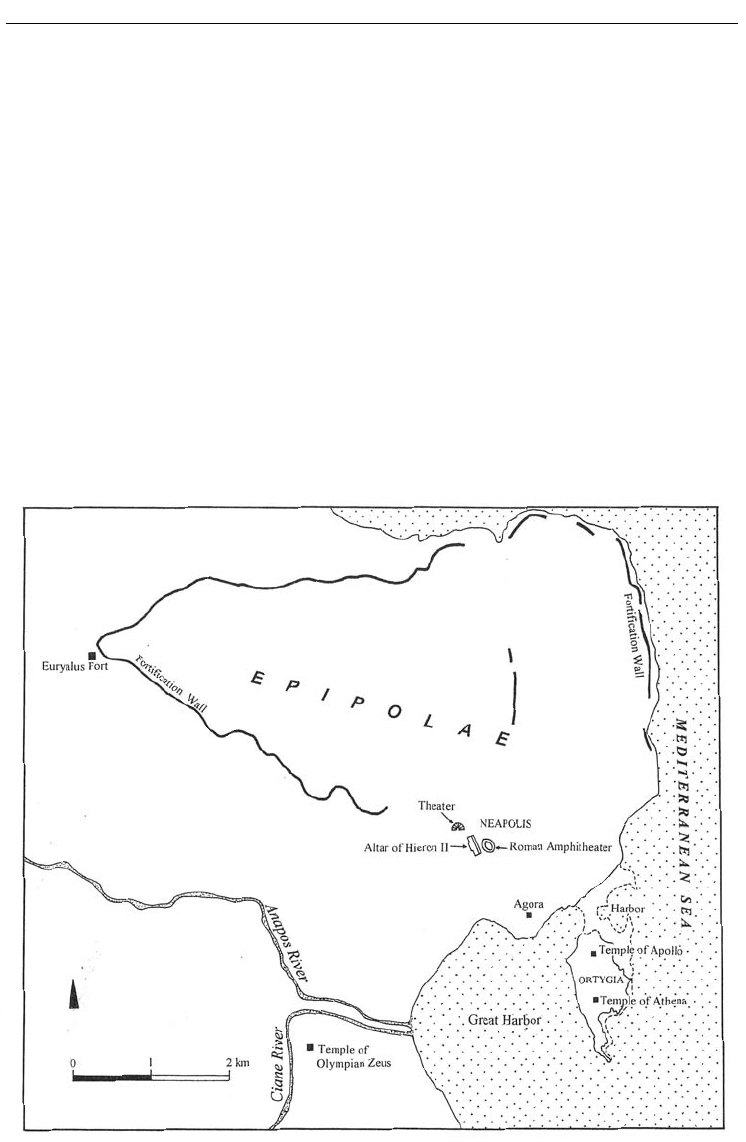
GREEK AND ETRUSCAN CITIES IN ITALY 315
was its most important city. Founded by Corinthians in the second half of the eighth century BC,
the town expanded from the small but defensible island of Ortygia (“the Partridge”) with harbors
on either side to the mainland beyond. In the mid-sixth century BC island and mainland were linked
by an artificial causeway (Figure 19.6). The city became one of the largest in the Greek world: its
population during the Classical period may have reached 250,000, comparable only to Athens.
Syracusan prosperity derived from agriculture, limestone quarries, and the harbors. But the
city’s political history was turbulent. As was typical in Sicily, tyranny rather than democracy
remained the dominant form of government. As elsewhere, the ruler had an important role in
creating works of art and architecture. However, in a brief evaluation of three tyrants, we shall see
that not all Syracusan rulers saw the need to promote themselves through art and architecture.
In 480 BC, the deposed tyrant of Himera (north Sicily) requested help from the Carthaginians.
In response, Gelon, tyrant of Gela and Syracuse, marched forth at the head of a coalition force
and won a great victory. The triumph at Himera over the non-Greek Carthaginians became the
western equivalent of the Battle of Salamis, the Greek victory over the Persians; indeed, Herodo-
tus recorded them taking place on the very same day. According to Diodorus Siculus, the Car-
thaginians were able to secure light armistice terms; grateful to Damarete, Gelon’s wife, for her
helpful intervention, they presented her with a gold crown weighing 100 talents. In commemora-
tion of the victory she had a decadrachm struck from this gold, a coin worth ten Attic drachmas,
Figure 19.6 City plan, Syracuse
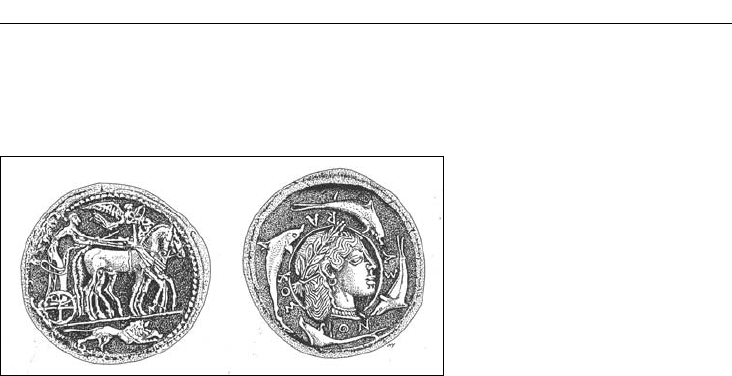
316 ANCIENT ITALY AND THE ROMAN EMPIRE
an unusually large denomination: the “Damareteion” it was called, named after her. The coin has
not survived. But its commemorative purpose may be reflected in a beautiful silver decadrachm
that has come down to us. Depicted on the coin are, on the obverse (front), a horseman in a quad-
riga, and on the reverse, the profile head of Arethusa, the local water nymph who served as the
symbol of the city, surrounded by
dolphins (Figure 19.7). After long
believing that it, too, celebrated the
victory at Himera, numismatists
now prefer to date this coin later,
with some specialists connecting it
with the expulsion of the tyrants in
466 BC.
Gelon himself celebrated his vic-
tory by commissioning two major
Doric temples: one at Himera, the
other at Syracuse, on Ortygia. The
latter, dedicated to Athena, mea-
sures 52m × 22m, with six columns on the short end, fourteen on the long. Local limestone was
used for its construction, with marble for details. Rich touches (now disappeared) included doors
of gold and ivory; in addition, the statue of Athena placed outside on the summit of a pediment
was supplied with a golden shield, its reflection visible far out to sea. In the seventh century AD
the temple was converted into a Christian church, with many elements, notably columns, incor-
porated into the design.
In 415–413 BC, the Athenians attempted to capture Syracuse, then an ally of Sparta. A dismal
failure, this expedition opened the way to the Spartan triumph over Athens at the end of the Pelo-
ponnesian War. Soon after, the Carthaginians invaded Sicily, also unsuccessfully. By 405 BC the
important tyrant Dionysios I had come to power. Ruthless at home, aggressive abroad, fighting
against Carthage, the Etruscans, and other Greek cities, he ruled until 367 BC, controlling at one
point over half the island. In contrast with many other rulers examined in this book, he did not
choose to advance himself through visual imagery, sculpted or painted, or create great religious
monuments. Instead, he patronized poets and writers; he himself composed tragedies. The archi-
tectural project for which he is remembered is military: a new fortification system protecting Syra-
cuse. Ortygia was reinforced, and a new wall reached out to enclose the Epipolae plateau, an area
eight times that previously fortified. At the far corner lay the Euryalus Hill, crucial for defense.
Little is known of the fort built here by Dionysios, but later reinforcement of the fourth and third
centuries BC is well preserved. It includes a sophisticated complex of towers, dry moats or ditches
cut from the bedrock, and underground passages allowing soldiers quick access to the different
parts of the walls and to the dry moats, in order to clear them of debris thrown in by the enemy.
The third century BC was dominated by the tyrant Hieron II (ruled ca. 271–216 BC). He showed
himself a true ruler of the Hellenistic age: influenced by the monarchs of the Hellenistic east, he
and his wife Philistis were the first rulers of Syracuse to have themselves depicted on the city’s
coinage. His building projects consist of big public monuments, exactly what we expect from a
successful ruler, the remodeling of a theater and a monumental altar. The theater illustrates the
transition from Greek design to Roman. Enlarged to hold 15,000 people, the theater, cut out of
a hillside, consisted of a half-circle of seating with a closely placed stage building with an elabo-
rate architectural backdrop. Unified seating and stage building would become the hallmark of
the Roman theater, with the Romans surpassing the Greeks by their ability to construct on flat
Figure 19.7 Silver decadrachm with Arethusa, Syracuse.
British Museum, London

GREEK AND ETRUSCAN CITIES IN ITALY 317
ground (with vaults) as well as on hillsides. Near the theater Hieron II had a monumental altar
built for the annual sacrifice of 450 oxen at the feast of Zeus Eleutherios. Not associated with a
temple but free-standing – recalling in this feature, at least, the later Altar of Zeus at Pergamon
– this altar is notable for its huge size (198m × 22.8m).
Hieron II had developed a close and friendly connection with Rome. After his death, the rela-
tionship soon turned sour, and in 212 BC the Romans captured and sacked the city after a bitter
siege lasting two years. Among the victims was Archimedes, a brilliant mathematician and inven-
tor. With this victory the Romans completed their takeover of south Italy and Sicily, and focused
their attention on their long-standing rival in the central Mediterranean, Carthage.
THE ETRUSCANS
We now turn to the Etruscans, a people occupying the Italian peninsula north of Rome during
much of the fi rst millennium BC. Distinct from the Greeks, heavily infl uential on the Romans
who eventually absorbed them, the Etruscans had a singular culture that is still imperfectly under-
stood. Before examining their cities, with a focus on architecture and tombs, a short survey of
key aspects of Etruscan history and culture is in order.
Etruscan history and culture
We follow the Romans in naming the Etruscans: “Etrusci,” not the Greek “Tyrrhenoi,” or their
own names, “Rasenna” or “Rasna.” Like the Greeks and the Latins (Romans), they were an
urban culture with important international connections. Much was absorbed from the western
Greeks with whom they traded, such as the alphabet, the Archaic style in sculpture and painting,
and the monumentality of temples, yet close inspection reveals that the Etruscans had their own
customs, divinities, and beliefs, which often seem, when judged by a Greco-Roman yardstick,
full of quirks.
With their homeland close to Rome, the Etruscans were the first great rival of the Romans,
and indeed ruled that city during the sixth century BC. They had a lasting influence on Roman
culture. The extent of their contribution is debated, but seems to include the Tuscan temple type,
the atrium house, realism in sculpture, the toga, the alphabet, so-called “Roman” numerals, ritu-
als for laying out a city and divining the will of the gods, and a taste for bloodthirsty games.
Their language, written in a form of the Euboean Greek alphabet (which they transmitted
to the Romans), first attested ca. 700 BC, nevertheless differs from Greek, Latin, or the other
languages of ancient Italy. Indeed, it is not a member of the Indo-European language group,
and has no known relatives. Because surviving texts are short, the language is imperfectly under-
stood. Promise of a breakthrough was held out by the discovery in 1964 at Pyrgi, the harbor of
Caere (Cerveteri), of three gold plaques, dated to ca. 500 BC, with the longest known dedicatory
inscriptions, all from Thefarie Velianas, a king of Caere, to the goddess Uni (Roman Juno) (=
the Phoenician goddess Astarte). Two were written in Etruscan, and a third in Punic (Phoeni-
cian/Carthaginian). Unfortunately, the Punic and Etruscan texts are not exact translations of
each other, so the value for decipherment was limited.
For Etruscan history, we rely particularly on Roman literature. The other main source of
knowledge about the Etruscans are their tombs, the impressive rock-cut chambers with painted
or carved walls, in their most elegant manifestations, and, when untouched by tomb robbers,
wonderful repositories of objects both local and foreign. Their cities, in contrast, have been

318 ANCIENT ITALY AND THE ROMAN EMPIRE
poorly preserved, often beneath later towns, and have traditionally been of little interest for
archaeologists accustomed to the handsome rewards of the tombs. Recent excavations of cities
are aiming to rectify this gap.
The heartland of the Etruscans was Etruria, a triangular area marked by the Arno River on the
north, the Tiber River and the Apennine Mountains on the east, and, as a north-west to south-east
hypotenuse, the Tyrrhenian Sea on the west. This well-watered land of hills and plains is favor-
able for agriculture and the raising of animals. In addition, the region has mineral resources, iron
(notably on the island of Elba), copper, and silver, in particular. International commerce devel-
oped in these resources, to judge especially from the Greek pottery found in Etruria, although
major cities were never located directly on the seacoast, a response to the menace of piracy, an
activity in which the Etruscans themselves earned notoriety.
The origins of the Etruscans have been a subject of controversy ever since Classical antiq-
uity. In the eighth and seventh centuries BC, Etruscan culture attained a degree of sophistication
unmatched by the other cultures of the peninsula. This unusual and rapid rise has piqued the
curiosity of generations of scholars. What is the explanation? Were the Etruscans one of the
many peoples already in place on the Italian peninsula in the early first millennium BC, or did they
immigrate to Italy from elsewhere?
According to one theory circulating in ancient times, Etruscan culture was brought to Italy by
invaders. Herodotus tells us they came from western Asia Minor, Lydian refugees from a famine.
Other Greek writers identified them with Pelasgians, a shadowy Aegean people of the pre-literate
period. Indeed, there are some surprising parallels in Anatolia: the tumulus burials (shared with
the Lydians and Phrygians of Anatolia), and the inscription, in a language that resembles Etrus-
can, on a late sixth-century BC funerary stele from the north-east Aegean island of Lemnos.
In an opposing opinion, Dionysios of Halikarnassos (first century BC) concluded that the
Etruscans were not immigrants into Etruria, but had always lived there. Indeed, archaeological
evidence indicates a continuous evolution from the early Iron Age Villanovan Culture of north-
ern and central Italy to the Etruscan. But the striking parallels with features from the Aegean,
Anatolia, and even Europe to the north suggest that foreign influences penetrated Etruria in
the formative stage of Etruscan culture. Thus, both sides in the ancient argument were to some
extent correct.
The Etruscans did not have a unified government, but instead, like the Greeks, were orga-
nized in city-states, grouped in a league traditionally consisting of twelve members. Kings and
aristocrats ruled the cities. During the eighth and seventh centuries, the Etruscans extended their
influence northwards to the Po River valley, and to the south, to Latium and Campania. Etruscan
kings ruled in Rome itself from ca. 600–509 BC. The Etruscans then suffered an extended series
of blows. Defeated in a naval battle by Syracuse in 474 BC, Etruscan sea power declined. Gauls
raided into Italy from the north in the fifth and fourth centuries BC, and Umbro-Sabellian tribes
took the Etruscan cities of Campania in the course of their migrations westward across the pen-
insula. A long struggle with Rome ensued, ending finally in the early first century BC in complete
Roman victory. Etruscans received Roman citizenship in 90 BC, and indeed Etruscan civilization
was by this point completely absorbed into the Roman world.
Cities and their architecture
As stated above, the cities have not survived well in the archaeological record. City sites were
long inhabited, even up to the present day in such interior towns as Perugia and Orvieto, causing
the altering or obliterating of early remains. In addition, only the foundations of houses were
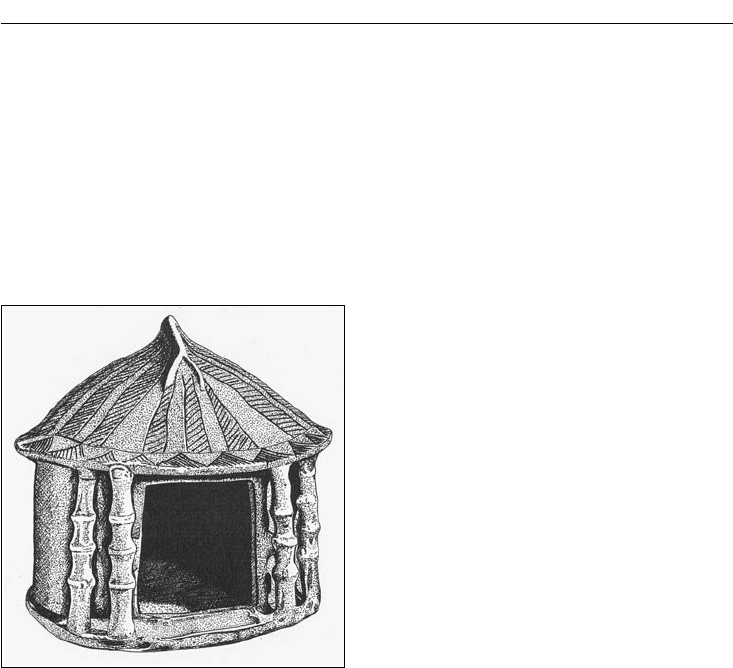
GREEK AND ETRUSCAN CITIES IN ITALY 319
made of stone, the superstructure consisting of perishable materials such as wood and sun-
dried mud bricks. The same mix of materials, stone foundation and mud brick superstructure,
seems favored in city walls, likewise often poorly preserved. But the attention of archaeologists is
increasingly turning to the remains of cities to answer questions about Etruscan society that the
better explored tombs cannot.
In southern Etruria, the distinctive topography determined the siting of cities. River valleys
have cut through the tufa, a soft volcanic stone that predominates here, leaving prominent hills
with steep sides. Such bluffs offered fine defensive advantages, and the Etruscans habitually
selected them for their town sites right from the early Iron Age or Villanovan period (from
the tenth century BC). Homes then were simple, one-room huts with wattle-and-daub walls and
thatched roofs. Design, construction details,
and decoration of such houses are best known
from small terracotta hut-urns, one popular type
of container for the ash and bone remains of a
cremated body (Figure 19.8). Such house mod-
els recall those from Iron Age Greece, indicating
similar house design even if the Greek models
served a different function: votives, not ash
urns.
Town layout in the Etruscan heartland was
apparently determined by the topographic
demands of individual sites. Streets had to con-
form to the irregular contours of the hilltop
locations. But the Etruscans were renowned
for an orthogonal town plan, dominated by two
main streets that crossed at right angles in the
center of the town. The Romans favored this
feature, and called the two streets the cardo (run-
ning north–south) and the decumanus (east–west).
Orthogonal layouts are known especially from colonies on more hospitable level terrain; see
below for a well-known example, Marzabotto. Within Etruria, the necropolis at Orvieto shows
an orthogonal plan, with streets oriented according to the compass. In part of the contemporary
cemetery at Cerveteri, efforts were made to create a regular plan.
Roman authors record the Etruscan ritual for laying out a new city. The Romans themselves
borrowed the rite at an early date. The founder of a city yoked a bull and a cow to a plough and
dug the perimeter line of the town. At the places where gates were intended, the founder lifted
the plough out of the ground and carried it across the space. The gateways were thus breaks in
the sacred circle, places through which mortals, animals, and their unclean possessions could
pass. According to Servius (fourth century AD), the ideal Etruscan town had three gates, three
main streets, and three main temples to the supreme divinities Jupiter, Juno, and Minerva. No
Etruscan town has as yet displayed these features. They can be seen, however, at Cosa, a Roman
colony planted in Etruria in 273 BC (see Chapter 20).
Marzabotto and Acquarossa
In the late sixth century
BC, the Etruscans established a colony at the site of Marzabotto, near
Bologna in the Po Valley, across the Apennines from Florence. Its ancient name is unknown.
Figure 19.8 Villanovan Hut-urn. Museo
Nazionale Preistorico, Rome
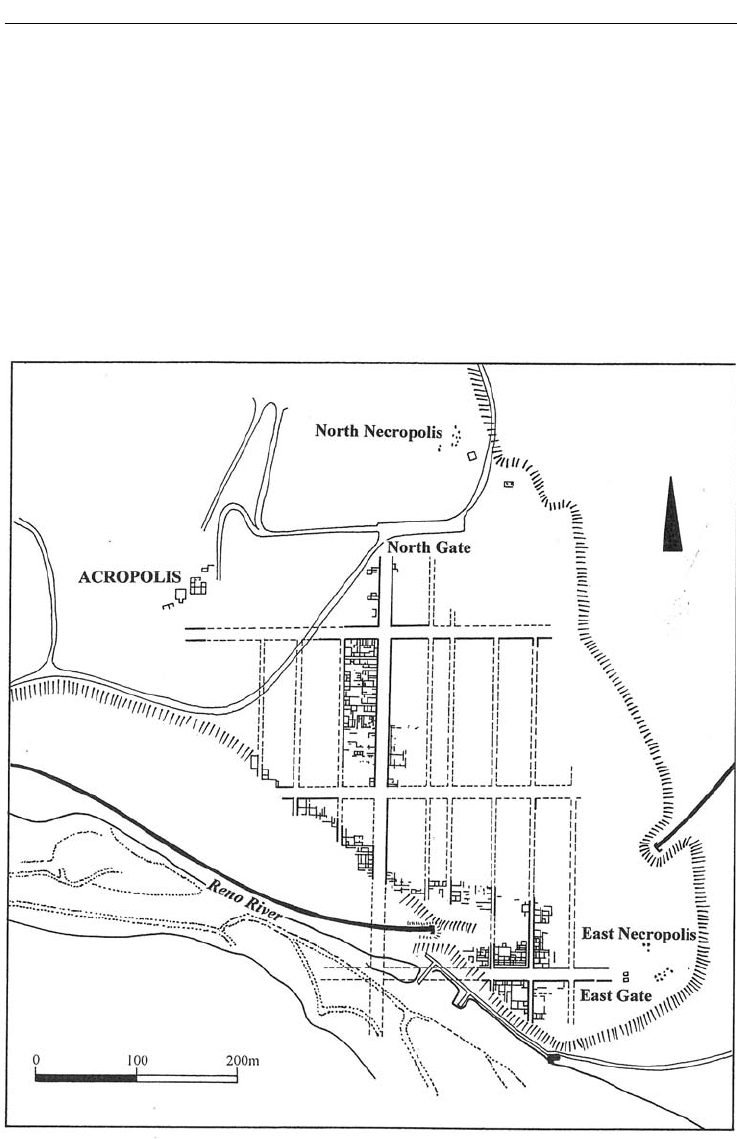
320 ANCIENT ITALY AND THE ROMAN EMPIRE
The settlement had a relatively short life. Gauls raiding from the north destroyed the town in the
fourth century BC as they pushed the Etruscans back into their Etrurian heartland. Well-studied,
Marzabotto is the classic example of early Etruscan orthogonal town planning.
As a new foundation, the town could be neatly planned. Indeed it was, with wide streets run-
ning north–south and east–west, and narrower streets in between (Figure 19.9). Although a single
north–south artery is known, three broad east-west streets were discovered. One of the east–west
streets can be identified as the decumanus, because there is a surveyor’s mark at the intersection
of the north–south street and only one of the east–west streets. All streets were lined with one
or two drainage canals; stepping stones laid in the center of some streets protected pedestrians in
case of overflowing rain, mud, and sewage. Temples and altars stood on a terrace to the north-
west of the town proper, with three of the temples sharing the same orientation as the town grid.
In contrast with Greek cities, an agora or city center with public buildings seems absent.
Figure 19.9 City plan, Marzabotto
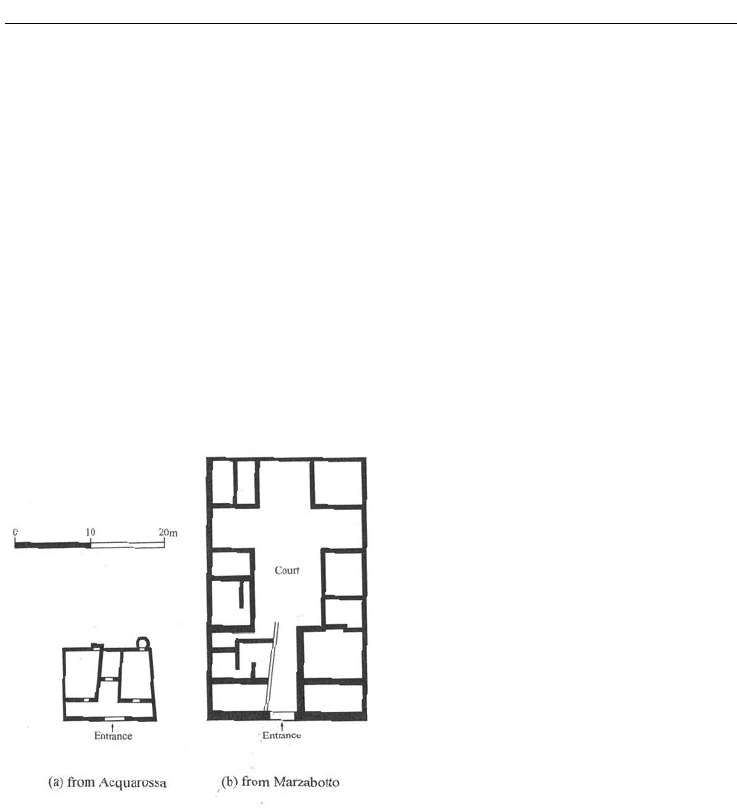
GREEK AND ETRUSCAN CITIES IN ITALY 321
Both temples and houses consisted of wood and mud brick superstructures erected on stone
foundations. The houses were organized around a large central court bordered by a low wall and
provided with a basin and, below, a cistern for the collection of drinking water (Figure 19.10b).
A covered drain ran out to the street. At the rear of the court, a large room opened in its entire
width onto the court. This room was flanked on either side by a smaller room. This layout recalls
the later Roman atrium house, thus suggesting an Etruscan ancestry for the distinctive Roman
house form.
Excavations conducted by the Swedish Institute at Rome from 1966 to 1975 at Acquarossa,
near Viterbo, discovered important remains of Etruscan houses dating to the seventh and sixth
centuries BC. The lower courses were built of tufa blocks, the superstructure of the usual mud
bricks reinforced with timber vertical and horizontal members. In addition, twigs were inter-
woven between the vertical and horizontal beams, then covered with plaster. This type of wall
construction, wattle-and-daub, was described by Vitruvius, the important Roman architect and
writer. Elements of the roof construction were found as well: roof tiles, both pans and covers,
and, for the ridge pole, larger curved ridge tiles. The pan tile is the flat tile with its edges turned
up, whereas the cover tile, as its name suggests, is a U- or V-shaped tile placed upside down over
the edges of joining pan tiles in order to prevent rain from entering between the tiles. One pan
tile even had one large hole and a small hole next to it, a small skylight or smoke hole.
The plans of the houses do not focus on a central court (Figure 19.10a). Instead, a porch leads
into two rooms, or a small paved entrance hall gives access from the street to rooms to the right,
left, and rear.
Veii and the “Tuscan Temple”
Veii, the Etruscan city closest to Rome, was important and powerful until Rome conquered it in
396 BC. Situated on a hill, the inhabited area of Veii displays an irregular layout (determined by
the topography) with occasional sections in a grid. But investigations in this area have been spo-
radic. Of greater interest for us is the temple in the Portonaccio sanctuary outside the city walls.
Although the sanctuary site is poorly preserved and details of the reconstruction are debated, this
Figure 19.10 House plans, from (a) Acquarossa
and (b) Marzabotto
